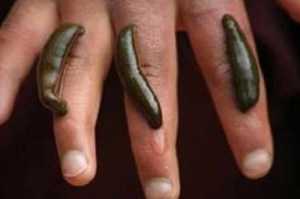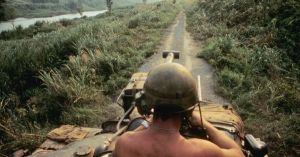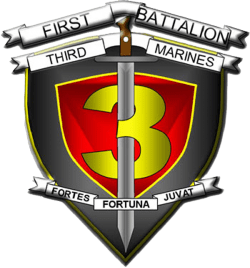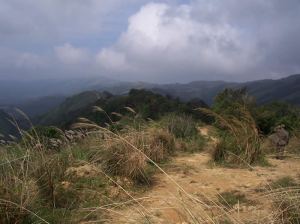My guest today, Michael B. Taft, retired as an ironworker and dairy farmer. He was an infantryman in A Company, 1st Battalion, 3rd Marines from 1966 to 1967. Below, he tells a story about his patrols through the mountains around Khe Sanh…the same hills that will conceal thousands of NVA troops a few months later.
MICHAEL B. TAFT – on patrol near Khe Sanh, South Vietnam, 1967
In early October 1966, the men of the men of “A Co.,” my rifle company, part of the 1st Battalion, 3rd Marine Regiment, boarded C-130 cargo planes for the short flight to a hilltop Special Forces base in the far northwest corner of South Vietnam called Khe Sanh.
Within days, the entire battalion arrived, along with a battery of 105-millimiter howitzers. My battalion, known as 1/3, had been deployed around Danang, along the Vietnamese coast, helping to “pacify” civilians — assisting with farming, improving security, anything to keep the Communists from extending their influence among the population. Now we had a new and much different mission. Decision makers in Saigon and Washington had charged the Marines with fortifying the northern border and defeating the influx of Communist forces.
 Khe Sanh basecamp from the air
Khe Sanh basecamp from the air
At Khe Sanh, 1/3, was assigned base security, providing reaction forces for reconnaissance units and interdicting North Vietnamese activity in the area. It was a grueling job — but it also provided an up-close view of the crescendo of enemy activity that would culminate, months later, in the dramatic siege of Khe Sanh and the Tet offensive. Astride the old French colonial Route 9 and just six miles east of Laos, the Khe Sanh Special Forces base sat on a plateau in a valley, deep within the Annamite Mountains. Immediately north of the plateau and hundreds of feet below, the spectacular, fast-moving Quang Tri River had cut a deep gorge on its way to the South China Sea at Dong Ha. To the west sat a mass of 3,000-foot hills, both an extraordinary spectacular beauty and a forbidding terrain of dense, triple-canopy forest growing in laterite soil. It would also soon be the scene of some of the bloodiest fighting of the war.
We patrolled in small fire teams, larger reinforced squads and platoon-size groups of 30 to 40 men. These patrols could last up to two weeks. We often climbed well into the 100-foot broad-leafed trees, observing the vast, impenetrable jungle and trying to find terrain features that corresponded to our maps. The maps were drawn from old French military maps and air photos interpreted by American sources, and they were usually highly inaccurate. For example, we might suddenly come across a ravine, hidden below the canopied forest, with sides so steep it could barely be climbed, hundreds of feet deep with a narrow stream at the bottom. We had no idea it was there — the mapmakers had simply missed it.
The abundance and diversity of wildlife was stunning. Bamboo vipers, six-foot cobras, foot-long centipedes, scorpions, small deer, multicolored Asian jungle birds and large monitor lizards. Occasionally, somewhere nearby, we would hear a tiger attacking wild hogs. The thunderous roar of a full-grown tiger was as frightening as any experience in Vietnam. But a bigger concern was much smaller: While on patrols, whenever we stopped to rest we would use lit cigarettes to shed our lower bodies of dozens of leeches.
 Though we were in a tropical jungle, the weather was mostly a bone-chilling 45 degrees, under monsoon rains, fog and drizzle. We wore long underwear under our jungle utilities, and dried our socks by tying them around our waists. More-level parts of the region contained intermittent bamboo thickets and tall, sharp-edged elephant grass that cut, then infected, uncovered skin and tore apart our clothing.
Though we were in a tropical jungle, the weather was mostly a bone-chilling 45 degrees, under monsoon rains, fog and drizzle. We wore long underwear under our jungle utilities, and dried our socks by tying them around our waists. More-level parts of the region contained intermittent bamboo thickets and tall, sharp-edged elephant grass that cut, then infected, uncovered skin and tore apart our clothing.
In late January 1967, we went out on one of the multitude of long and short range patrols in and around Khe Sanh. Codenamed King Kong, it was an A Co. operation. I was the radio man for a reinforced rifle squad, which in those times consisted of about 20 Marines — 12 riflemen, a machine gun team, a corpsman (or medic), an artillery forward observer, his radioman and a patrol leader. The patrol was to last several days, and we would be resupplied with rations by helicopter. Starting from our company’s position on the Khe Sanh perimeter, we climbed down to the Quang Tri River. After fording the fast-moving, chest-high water, we built fires, dried our clothing and were on our way. Several large tiger tracks dotted the wet sand at the river’s edge. The terrain was extremely difficult, and we were lost more often than not. Since we’d been in these hills for months, the situation was in fact the normal course of events.
What was not normal occurred during the last days of King Kong. I was breaking brush for the patrol. Machete in hand, I led the way up a jungled hillside from the gorge bottom below. We were looking for someplace, any place, where we could make radio contact and could be resupplied. Suddenly, at the top of the hill, I broke into a large, hilltop open space that had been a position used by South Vietnamese Army units. It was well above a portion of Route 9, at a sharp bend in the Quang Tri River. Below, we could see several old colonial buildings, a bridge and the surrounding forest. Thankful for our good fortune, the Marines of King Kong set up defensive positions at the opening’s edges, made radio contact and arranged for resupply and possible extraction.
Just then, someone noticed a large number of uniformed men below, bursting from what seemed to be everywhere, moving swiftly, headed east and away from us on Route 9. We thought they were North Vietnamese, and there were lots of them. Marine UH-1 helicopters arrived, dropped some rations and flew down to check the troops below. They confirmed our suspicions. King Kong had come across a small part of the huge enemy buildup that would explode into the bloody “hill fights” of 1967, which in turn culminated in the siege of Khe Sanh that fall. We were in a tight spot. If the North Vietnamese decided to assault our position, the approaches they would probably take would be beyond the reach of our supporting artillery. However, the reach of the artillery could bracket the North Vietnamese as they moved away, and the forward observer got right to work calling in 105-milimeter artillery fire from Khe Sanh. Several dozen 105 rounds crashed into the areas where the rapidly disappearing North Vietnamese had been.
The patrol leader discussed several options over the radio with our company commander, back in Khe Sanh. Night was quickly approaching. There were no helicopters available for extraction. One option would be to backtrack back down the hill we’d climbed earlier, but then we’d be out of radio contact and floundering in the darkness. If we marched down to Route 9 and headed west, we would be headed to Khe Sanh, several miles away, but would be subject to ambush if any North Vietnamese were along the highway. Our existing position was acceptable for defense, and the decision was made to spend the night.
We improved the existing fighting holes, set a listening post and positioned the machine gun to command the likely path of assault. It was a long, uneventful night for the exhausted members of King Kong. Morning came, and word arrived from Khe Sanh for the patrol to take Route 9 west and meet up with several trucks that would be sent east as far as possible from the base. Single file and extremely alert, we went down the hill to Route 9 — nothing yet. Once down, we spread out in single file along each side of the road, the Quang Tri River below on our left, the jungle on the right. Moving briskly, we crossed several partially destroyed bridges during the several-hour march west.

Suddenly we saw trucks with a rifle squad from our company hidden around them. We quickly climbed in and were on our way. Back at Khe Sanh, we were taken to a large, heated tent, where we would spend a free night, no guard duty. As a reward for our efforts, each of us had the choice of a can of soda or beer. I took the beer.
Thank you, Michael for your service, and Welcome Home! Semper Fi! This story originally ran in the New York Times on Sunday, May 12, 2017.
Thank you for taking the time to read this. Should you have a question or comment about this article, then scroll down to the comment section below to leave your response.
If you want to learn more about the Vietnam War and its Warriors, then subscribe to this blog and get notified by email or your feed reader every time a new story, picture, video or changes occur on this website – the button is located at the top right of this page.
I’ve also created a poll to help identify my website audience – before leaving, can you please click HERE and choose the one item best describing you. Thank you in advance!












Thank you for your service and thank you for sharing I’m glad you made it home. My dad was in the Marines for 20yrs he was in Vietnam & Korea i loved hearing the stories about his time over there he didn’t like talking about it that much but he knew I loved hearing about his time there and the friendships that were formed…..Again thank you for your service 🙏 ❤
LikeLike
Perhaps the best description of topography/weather/vegetation and steps taken to negotiate the difficulties… and the sense of dread (perhaps born more of vigilance than fear) is a spot-on description of young men from a familiar temperate zone trying to stay alive in a cold tropical maze…
I’ve told friends and family for 49 years that it was downright COLD in the early morning mist that formed in the valleys west of Hue, Wuang TRI and Dong Ha; especially near A Shau Valley up toward Route 9…
I think they humored me but thought I was nuts… thanks for the validation!
Welcome home
LikeLike
was there , radio operator bravo 1/ 13. north end of the runway by rubber fuel bladders. we replaced the special forces who went to lang vei. runway of mars matting was replaced with aluminum.
LikeLike
Thank you and Welcome Home!!
LikeLike
When ever i see a Nam Vet, my greeting is WELCOME HOME!!!! We did not hear that much.
I will add Semper Fi to that.
USME 1970-74
LikeLike
I like it.
LikeLike
As a Vietnam vet I can appreciate the hardships the men of A Co / Operation King
Long endured. God bless each and everyone of them. May the rest of their lives be long, enjoying good health and prosperity in all their
endeavors.
Unlike many vets of different wars, I do enjoy
reading and learning about the different
operations/ battles, particularly those involving
the Vietnam War. Personal experiences are
those that I care more about reading as they
tell a story as seen only through the writers
eyes.
I was in QuiNhon at the time Operation King
Long took place. Those Marines did deserve
a great deal more than choice of “soda or a beer” on there return to Base Camp.
Thanks for sharing this time in history as it
is like so many others that occurred in the
War Zone.
God bless all,
Carl Williams, PA
CW4 (R) AUS
( Medic and Lanoratory Spec at the time)
LikeLike
Though I was with the Army, served as a photographer, I had spent time in the Central Highlands. The terrain was just as described. What is ironic, over the years, I spent time describing both the beauty and fear of these mountains and valleys, I would always say, ‘it was like an old King Kong movie. The jungles, granite mountains, wildlife, morning fog, mist, and sounds.
Ironic, the codename used by the Marines was, KING KONG. I wonder if the name came about as a result of many perceiving it as I did.
WELCOME HOME!
LikeLike
Hi Michael,
I too want to thank you for your service and sharing your story. It was intense as most real stories from Vietnam are.
Thank you John for sharing another hero’s story. You are the best.
LikeLike
Thank you for highly descriptive briefing about the the geography of Route 9/Quang Tri River…
I knew Route 547 (Thua Thien Province from Hue to AShau Valley), but wondered about the geography/topography 50 miles north..
Not too dissimilar.
I was in 101st Airmobile Assault (aka ‘airborne) in 1970-71
I had no idea in Nov-’71 that 3 months later tens of thousands of NVA would decide to end their concealment and attack… in glad I left just before hell broke loose…
LikeLike
Well done, Marine! Welcome home and thank you for sharing your story.
LikeLike